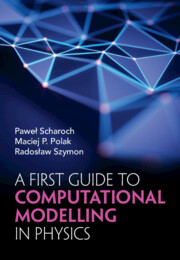Book contents
- Frontmatter
- Contents
- Preface
- How to Use the Book
- First Steps
- Project 1: Rectangular Finite Quantum Well – Stationary Schrödinger Equation in 1D
- Project 2: Diffraction of Light on a Slit
- Project 3: Pendulum as a Standard of the Unit of Time
- Project 4: Planetary System
- Project 5: Gravitation inside a Star
- Project 6: Normal Modes in a Cylindrical Waveguide
- Project 7: Thermal Insulation Properties of a Wall
- Project 8: Cylindrical Capacitor
- Advanced Projects
- Project 9: Coupled Harmonic Oscillators
- Project 10: The Fermi–Pasta–Ulam–Tsingou Problem
- Project 11: Hydrogen Star
- Project 12: Rectangular Quantum Well Filled with Electrons – The Idea of Self-Consistent Calculations
- Project 13: Time Dependent Schrödinger Equation
- Project 14: Poisson’s Equation in 2D
- Appendix A: Supplementary Materials
- Further Reading
- Index
Project 13: - Time Dependent Schrödinger Equation
Published online by Cambridge University Press: 01 February 2024
- Frontmatter
- Contents
- Preface
- How to Use the Book
- First Steps
- Project 1: Rectangular Finite Quantum Well – Stationary Schrödinger Equation in 1D
- Project 2: Diffraction of Light on a Slit
- Project 3: Pendulum as a Standard of the Unit of Time
- Project 4: Planetary System
- Project 5: Gravitation inside a Star
- Project 6: Normal Modes in a Cylindrical Waveguide
- Project 7: Thermal Insulation Properties of a Wall
- Project 8: Cylindrical Capacitor
- Advanced Projects
- Project 9: Coupled Harmonic Oscillators
- Project 10: The Fermi–Pasta–Ulam–Tsingou Problem
- Project 11: Hydrogen Star
- Project 12: Rectangular Quantum Well Filled with Electrons – The Idea of Self-Consistent Calculations
- Project 13: Time Dependent Schrödinger Equation
- Project 14: Poisson’s Equation in 2D
- Appendix A: Supplementary Materials
- Further Reading
- Index
Summary
This project looks into the time evolution of a wave function within a two-dimensional quantum well. We start by solving the time-dependent Schrödinger equation for stationary states in a quantum well. Next, we express any wave function as a linear combination of stationary states, allowing us to understand their time evolution. Two methods are presented: one relies on decomposing the wave function into a basis of stationary states and the other on discretisation of the time-dependent Schrödinger equation, incorporating three-point formulas for derivatives. These approaches necessitate confronting intricate boundary conditions and require maintaining energy conservation for numerical accuracy. We further demonstrate the methods using a wave packet, revealing fundamental phenomena in quantum physics. Our results demonstrate the utility of these methods in understanding quantum systems, despite the challenges in determining stationary states for a given potential. This study enhances our comprehension of the dynamics of quantum states in constrained systems, essential for fields like quantum computing and nanotechnology.
Keywords
- Type
- Chapter
- Information
- A First Guide to Computational Modelling in Physics , pp. 81 - 85Publisher: Cambridge University PressPrint publication year: 2024

